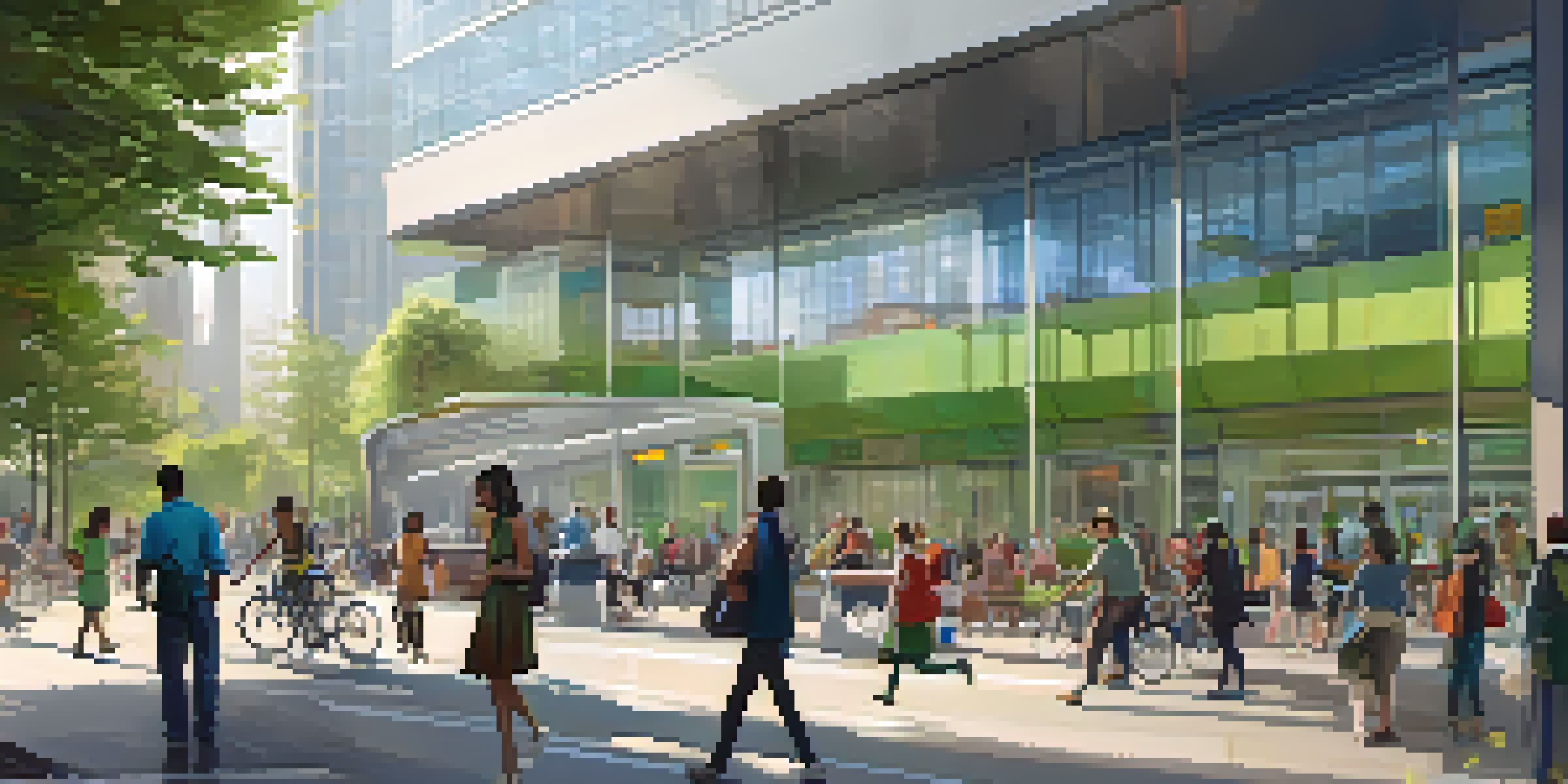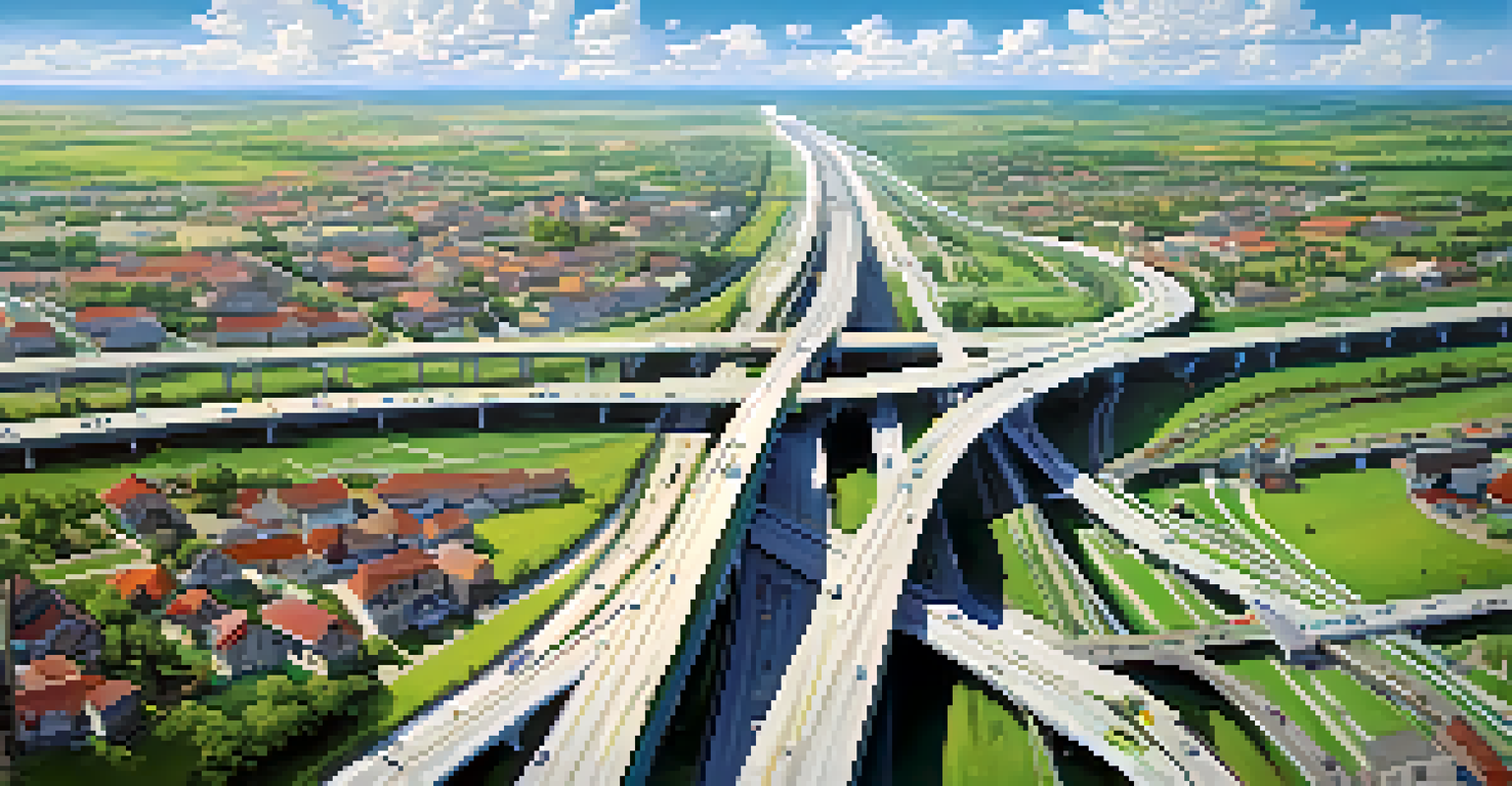The Benefits of Investing in Transportation Infrastructure

Enhancing Economic Growth Through Infrastructure Investment
Investing in transportation infrastructure is a powerful catalyst for economic growth. When roads, bridges, and public transit systems are improved, they facilitate smoother movement of goods and people, which in turn boosts local and national economies. For instance, better roads can reduce travel times for freight, increasing efficiency for businesses and enhancing supply chain effectiveness.
Infrastructure is the backbone of our economy and the foundation of our communities.
Moreover, these investments create jobs not only during the construction phase but also in ongoing maintenance and operations. A well-maintained transportation network attracts new businesses, which can further stimulate job creation. Local economies often flourish as people have better access to employment opportunities and services.
In essence, the ripple effect of an improved transportation system can be felt across various sectors, from retail and tourism to manufacturing. As the economy grows, so does the tax base, allowing for further investments in public services and infrastructure, creating a virtuous cycle of growth.
Improving Public Safety with Better Transportation Systems
One of the most significant benefits of investing in transportation infrastructure is the enhancement of public safety. Upgraded roads and bridges can significantly reduce the number of accidents, as better design and materials lead to safer driving conditions. For instance, wider lanes and improved signage can prevent collisions and save lives.

Public transit systems also play a crucial role in safety. By providing reliable alternatives to personal vehicles, they can help reduce traffic congestion and the associated risks of road accidents. Additionally, well-lit and maintained transit stations offer safer environments for commuters, contributing to overall community safety.
Infrastructure Drives Economic Growth
Investing in transportation infrastructure boosts economic growth by improving the efficiency of goods and services movement.
Furthermore, investments in infrastructure can include features like pedestrian walkways and bike lanes, encouraging safer travel methods. These enhancements not only protect individuals but also foster a sense of community as people feel more secure navigating their neighborhoods.
Boosting Connectivity Between Communities and Regions
Transportation infrastructure serves as the backbone of connectivity, linking communities and regions together. Improved highways, railroads, and air travel options make it easier for people to access jobs, education, and healthcare. For example, a new expressway can reduce travel time between two cities, fostering economic and social interactions.
Transportation infrastructure is key to economic development and quality of life.
This connectivity is especially crucial in rural areas, where residents may otherwise feel isolated. By investing in public transportation options, such as buses or trains, these communities can gain access to urban centers, enabling them to participate more actively in the economy and society.
Moreover, enhanced connectivity can lead to cultural exchange and collaboration among different regions. As people travel more freely, they share ideas and foster innovation, enriching the local culture and economy.
Supporting Environmental Sustainability Through Smart Investments
Investing in transportation infrastructure can also support environmental sustainability. Modernizing systems to include electric public transit options or bike lanes encourages eco-friendly commuting, reducing carbon emissions. For instance, cities that enhance their bike networks often see a significant increase in cycling, resulting in cleaner air and less traffic congestion.
Additionally, investment in smart technologies, such as traffic management systems, can optimize the flow of vehicles and reduce idle times. This not only improves fuel efficiency but also lessens the environmental impact of transportation systems.
Enhancing Public Safety Through Design
Upgraded transportation systems significantly reduce accidents and improve safety for all road users.
By prioritizing sustainable transportation options, communities can create a greener future while also appealing to environmentally conscious businesses and residents. The shift toward sustainability is not just beneficial for the planet; it can also save money in the long term through reduced health care costs and environmental remediation.
Creating Jobs and Economic Opportunities for Local Communities
Transportation infrastructure projects are significant job creators, offering employment opportunities across various skill levels. From construction workers to engineers and project managers, these initiatives generate a wide range of jobs that often provide a pathway to stable careers. For many communities, this can be a game-changer in reducing unemployment rates.
Moreover, the economic opportunities extend beyond the direct jobs created by construction and maintenance. Local businesses can benefit from increased foot traffic and improved access to customers, leading to higher sales and growth. For example, a new road can make it easier for customers to reach local shops, boosting the economy.
In summary, investing in transportation infrastructure not only creates immediate jobs but also fosters long-term economic stability and growth. As communities thrive, they can invest in further development, creating a cycle of prosperity.
Enhancing Quality of Life Through Improved Infrastructure
A well-developed transportation system significantly enhances the quality of life for residents. Improved access to transportation can mean shorter commutes, allowing individuals more time for family, leisure, and community engagement. This can lead to happier, healthier lives, as people feel less stressed by long travel times.
Furthermore, with better transportation options, individuals have wider access to essential services like healthcare and education. This can be particularly beneficial for underserved communities, where public transit may be the only viable means of transportation. By investing in infrastructure, we ensure equitable access to opportunities for all.
Job Creation Through Infrastructure Projects
Transportation infrastructure initiatives create jobs and stimulate local economies by attracting businesses and increasing foot traffic.
Additionally, vibrant public spaces, such as parks and pedestrian areas developed alongside transportation improvements, can foster community interaction and well-being. A connected community often results in a stronger social fabric, enriching the lives of its residents.
Adopting Innovative Technologies for Future-Ready Infrastructure
Investing in transportation infrastructure allows for the integration of innovative technologies, making systems more efficient and user-friendly. Smart traffic signals, for instance, can adapt to real-time traffic conditions, reducing congestion and improving travel times. These technologies not only enhance user experience but also contribute to safer roads.
Moreover, incorporating data analytics into transportation planning can lead to more informed decision-making. By analyzing traffic patterns and user behaviors, planners can design systems that better meet the needs of the community. This results in a more responsive infrastructure that can adapt to changing demands over time.

As we look to the future, embracing innovation in transportation infrastructure is crucial. It not only makes systems more efficient but also prepares communities for the challenges of tomorrow, ensuring they remain competitive and livable.
The Long-Term Economic Returns of Infrastructure Investments
While the initial costs of investing in transportation infrastructure can be significant, the long-term economic returns can far outweigh these expenses. Studies have shown that every dollar spent on public transportation generates approximately four dollars in economic returns. This means that investments in infrastructure can lead to substantial economic growth over time.
Furthermore, these investments often result in increased property values in surrounding areas. As transportation options improve, neighborhoods become more desirable, leading to higher real estate prices and tax revenues for local governments. This creates additional funding opportunities for community services and infrastructure projects.
In conclusion, the long-term benefits of investing in transportation infrastructure are profound. By fostering economic growth, enhancing public safety, and improving quality of life, these investments pay dividends for generations to come.